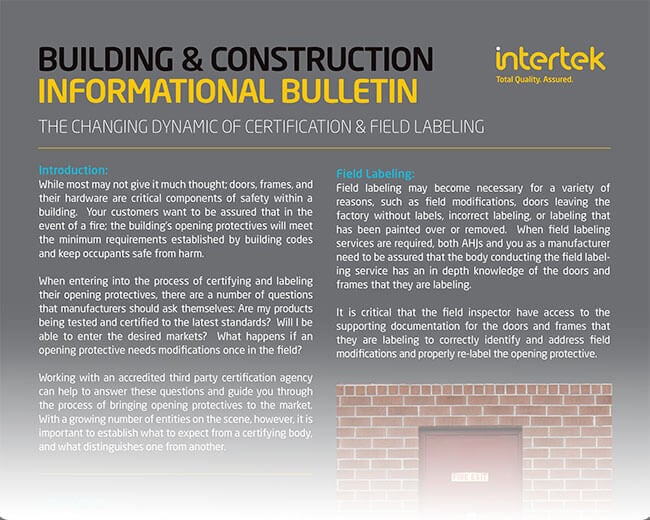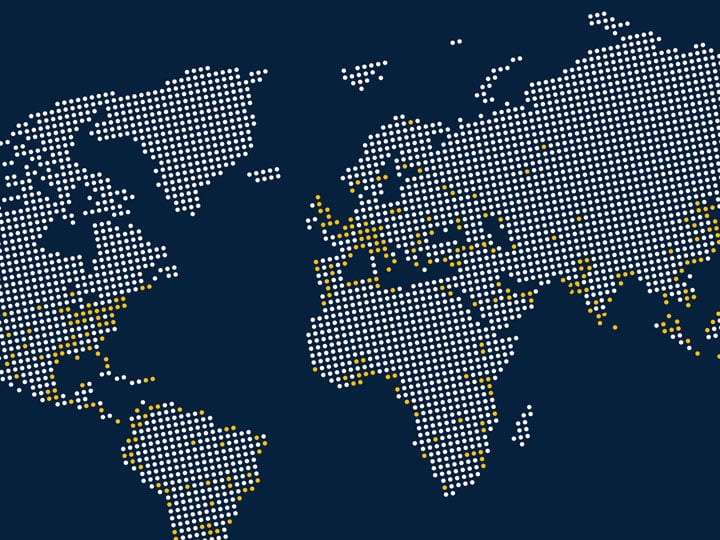Field Evaluations to Nationally Recognized Standards and Local Building Codes
Intertek performs Fire Door Certification and Labeling in the field with Inspection services to help ensure your fire door assemblies are code compliant and in working order. In a fire event, compliance with NFPA 80, Standard for Fire Doors and Other Opening Protectives, can make all the difference when it comes to occupant life safety and property protection.
Fire door Inspections are an integral part of your building’s overall fire protection system. A properly operating fire-rated door, just like a properly operating fire damper, is a key component to the compartmentalization of a building to stop the spread of deadly fire, smoke and toxic fumes. If the fire door assembly isn’t working properly, your facility is at risk. Fire door inspections will ensure your fire doors are code compliant and in working order during the event of a fire.
Field Evaluation Process
Field labeling of fire doors may become necessary for a variety of reasons, such as field modifications, doors leaving the factory without labels, incorrect labeling, or labeling that has been painted over or has been removed. When field labeling services are required, both AHJs and manufacturers need to be assured that the body conducting the field labelling service has an in-depth knowledge of the doors and frames that they are labeling according to NFPA 80 – 2022 Edition.
Remote Pre inspections for NFPA 80 / 101
Fire Door Modifications
If a client proposes a modification, we can review it for consideration through evaluation or possibly testing. Once the opening has been modified as needed, Intertek’s Warnock Hersey (WH-ETL) Mark is applied, indicating compliance with building and fire code requirements.
This valuable service may provide significant savings by avoiding the extensive costs involved with a complete tear-out and replacement of existing components and door assemblies.
Our team of experts can critically apply engineering judgements based on an extensive knowledge of both product performance and testing and work with you every step of the way.
Missing the correct certification mark?
If your already-installed fire doors are missing a proper certification mark, Intertek’s field labeling services can help you avoid removal and replacement of unlabeled openings.
We offer the following services to assist you:
- Conduct a comprehensive review of all components in question
- Provide you with a written deficiencies report
- Offer support for modifications and corrections
- Fire Door Maintenance – Noted within Chapter 5 of NFPA 80.
- Provide re-inspection services
- Apply the Warnock Hersey fire-rating label (when appropriate)
Our Field labeling serves a wide range of industry facilities including:
- Healthcare Facilities
- Hospitality
- Education
- Government Facilities
- Commercial -Industrial
- New and existing constructions, including renovation projects
Fire Door Field Labeling - Frequently Asked Questions
We follow the guidelines of NFPA 80 and NFPA 101, in addition to using past and present listing information in our database to identify potential fire doors and frames in the field and any non-conformances they may have.
A fire door label will show the door’s fire protection rating, the test standards that the door is certified to, a third-party certification mark, the manufacturer’s, machiners, or distributor’s name or logo (or a numerical code that can be used for traceability), and possibly the minimum latch throw (depending on the door design), among other information. If the door is approved for a temperature rise rating, this will also be indicated on the label. Other information that can potentially be found on a fire door label include the ‘S’ mark for smoke and draft applications, and a statement pertaining to the use of fire exit hardware.
Legal requirements for fire doors can be found in NFPA 80, the International Building Code (IBC), and NFPA 101. Certain jurisdictions may also adopt state or city building codes that may have requirements that differ slightly from the model building code (I.e., IBC). They key is understanding what version of each code or standard the jurisdiction is being enforced where the doors will be installed; keeping open communication with the Authority Having Jurisdiction (AHJ) is crucial.
Per Chapter 3 of NFPA, a fire door assembly is defined as any combination of a fire door, a frame, hardware, and other accessories that together provide a specific degree of fire protection to the opening.
The 'S' mark on a fire door label indicates that the door and frame assembly are in compliance with smoke and draft control per UL 1784 where listed and labeled Category H smoke and draft gasketing is installed. UL 1784 is a standard for testing and recording air leakage rates through a door and frame assembly at specified temperatures and pressures; however, actual leakage limits are specified by the IBC (Chapter 7) and NFPA 105.
Compliance is based on the certification listing requirements for the door, frame, and hardware as specified by the listing agency for these products and is also based on the installation and maintenance requirements found within NFPA 80. There are also more broad requirements and allowances for different types of occupancies which can be found in NFPA 101.
Fire doors, along with fire door frames and hardware form an opening protective that helps prevent the spread of fire throughout a building when the fire door assembly is installed and functioning properly.
A listing agency is an organization that provides product certification and inspection services. The listing agency may or may not also provide testing services as well as field services. Intertek is an ATIC company, providing assurance, testing, inspection, and certification services.
For standard annual inspections a ‘Qualified Person’ as defined by NFPA 80 – A person who, by possession of a recognized degree, certificate, professional standing, or skill, and who, by knowledge training, and experience, has demonstrated the ability to deal with the subject matter, the work, or the project. Field labeling of fire doors must be conducted by individuals or companies that are certified or listed or by individuals or companies that are representatives of a labeling service that lists the product.
What information should you provide the Intertek team prior to the inspection? Reason for inspection (I.e., annual inspection, modifications made? missing labels? Etc.), estimated number of affected openings if known, jobsite/address, timeline needed, building plans (if you have them) and/or details on field modifications (if applicable).
A Fire Marshal Inspection is a systematic examination conducted by a qualified fire marshal or fire inspector to assess buildings, facilities, or properties for compliance with fire safety regulations and standards. These inspections typically involve evaluating fire prevention measures, such as fire alarms, sprinkler systems, emergency exits, fire extinguishers, and other safety equipment. The goal is to identify potential fire hazards, ensure proper implementation of fire safety measures, and mitigate risks to protect occupants and property from fire-related dangers. Inspections may be conducted regularly or in response to specific concerns or complaints, with the aim of promoting fire safety and compliance with applicable laws and regulations.
- Location of the fire doors inspected and opening identifier
- The details of the opening
- List of and recommendation for deficiencies
- Report of field modifications made if any
- Date of inspection, name/address of facility, name and company of person performing the inspection
It is the process of field inspecting the door assembly against listing information (past and present) as well as performing the inspection requirements noted within Chapter 5 of NFPA 80. If the Intertek inspector determines that the door and/or frame is eligible to be labeled, then they may apply an Intertek label in the field.
The composition of the materials used in fire doors is often considered proprietary information between the manufacturer and the testing laboratory. We recommend contacting the manufacturer directly. They should be able to provide information about the materials used in their products. If the manufacturer is no longer in business or cannot provide the information you need, replacing the door may be the safest option. This will ensure compliance with current safety regulations and eliminate any potential health risks.
For additional asbestos solutions, visit our Asbestos Testing & Consulting page.
View our free on-demand webinar as our expert, Justin Hendricks, gives an introduction into North American fire door test methods and requirements, aspects of fire door certification, as well as look into NFPA 80 requirements and allowances.
Knowledge Center
Building Health & Wellness: An Overview of Services
Acoustical Testing & Consulting Resources
Remote Pre Inspections for NFPA 80 / 101
Protek - Safety. Everywhere. Every Day
Fire Doors 101: Your Guide to Testing and Certification - Webinar Recording
Tornado Testing & Certification Requirements - Webinar Recording
Plumbing Products Testing & Certification - Webinar Recording
The Evolving Code Evaluation Process White Paper
Proposition 65 & the Furniture Industry Webinar Recording
Why Planning for FCC Certification is Key to Success in the Door Hardware Industry White Paper





